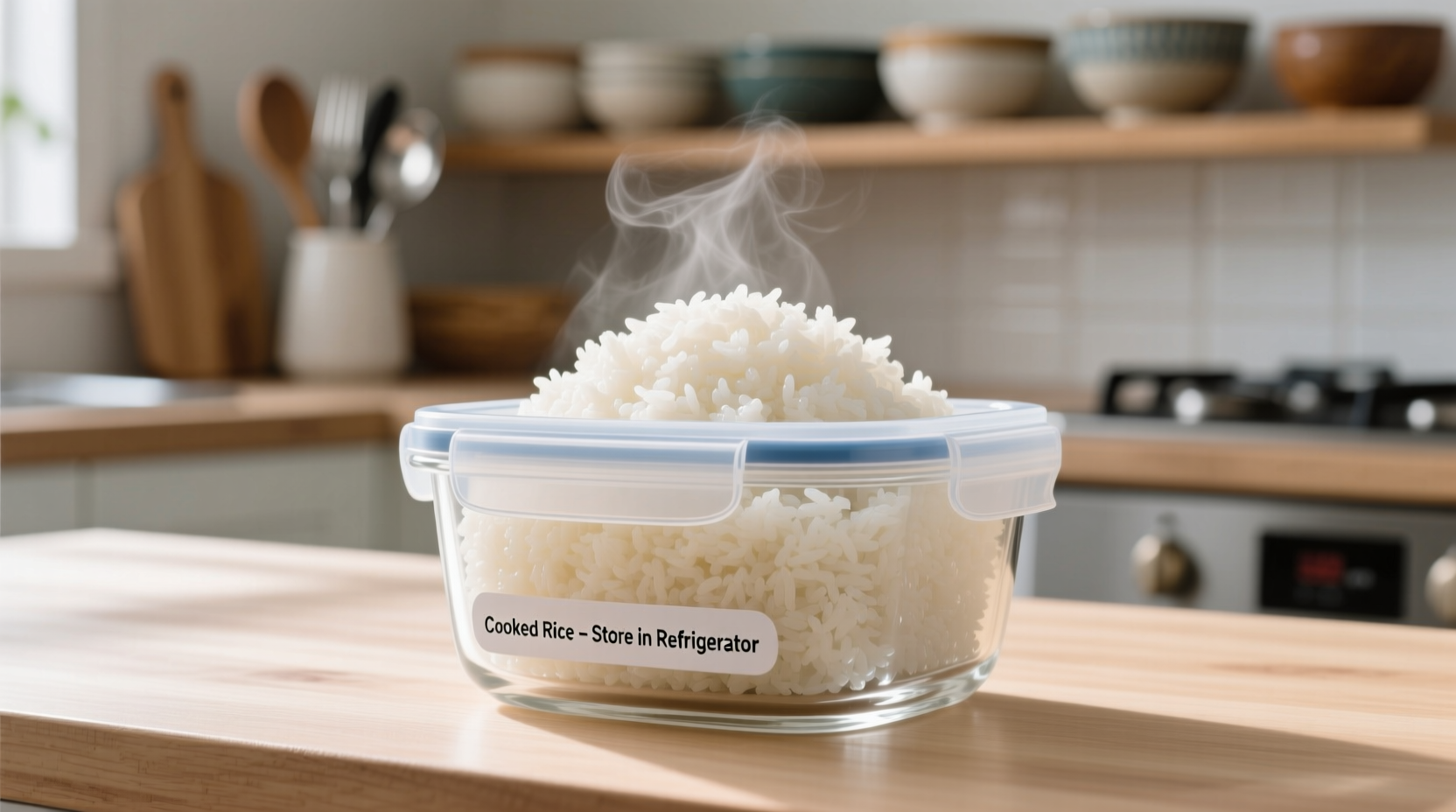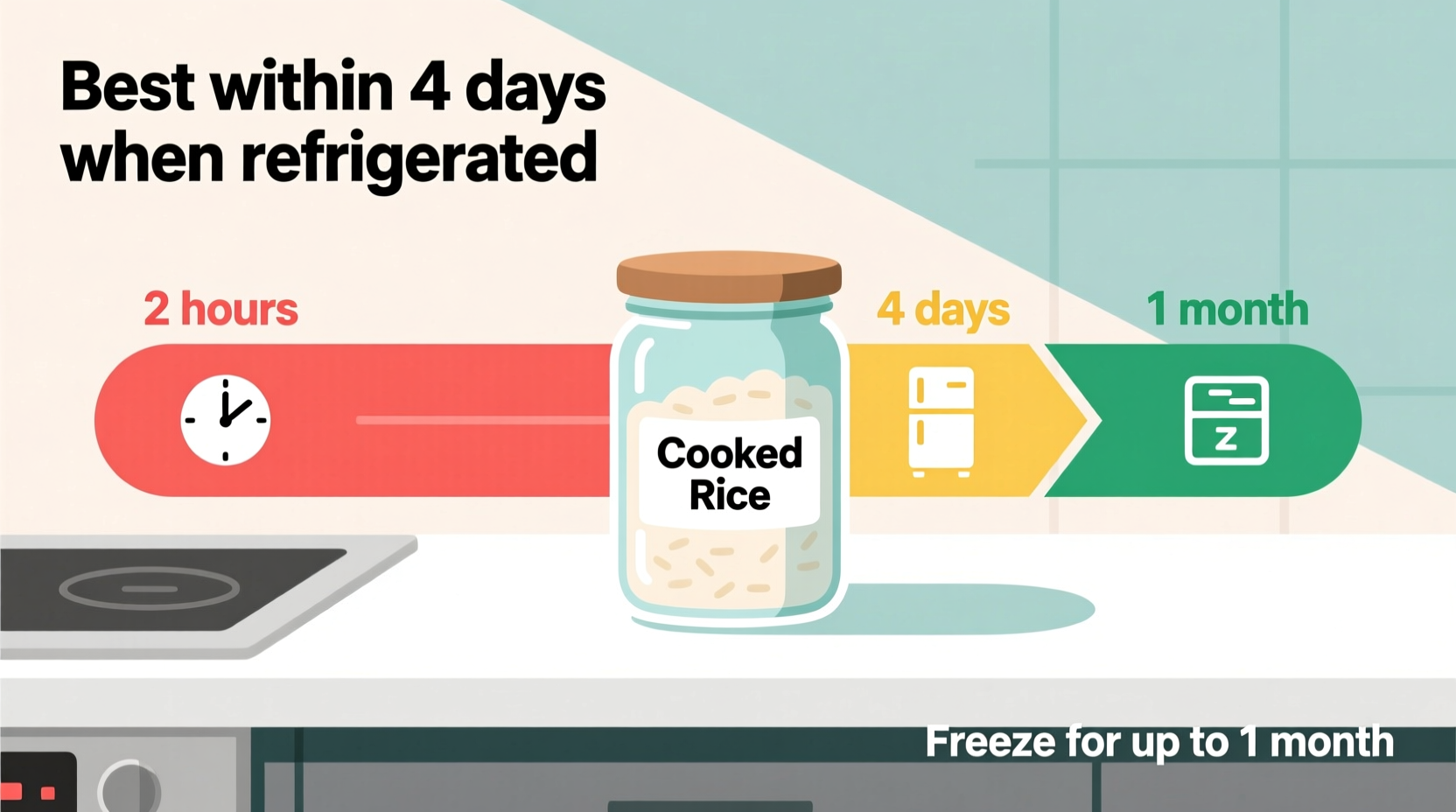The Critical Timeline for Safe Rice Storage
Understanding how long you can store cooked rice isn't just about preventing waste—it's crucial for avoiding foodborne illness. Rice presents unique food safety challenges because of Bacillus cereus, a resilient bacteria commonly found in raw rice that can survive the cooking process.
When cooked rice cools slowly or remains in the temperature danger zone (40°F-140°F/4°C-60°C), these bacteria multiply rapidly and produce heat-stable toxins. Unlike many foodborne pathogens, these toxins aren't destroyed by reheating, making proper storage timing absolutely critical.
Storage Guidelines by Method
| Storage Method | Maximum Safe Duration | Temperature Requirement | Quality Considerations |
|---|---|---|---|
| Room Temperature | 2 hours max | 70°F/21°C or below | Rapid bacteria growth after 1 hour |
| Refrigerator | 3-4 days | 40°F/4°C or below | Texture deteriorates after day 3 |
| Freezer | 1-2 months | 0°F/-18°C or below | Best quality within 1 month |
Why Rice Requires Special Attention
Unlike many cooked foods, rice harbors Bacillus cereus spores that survive cooking. The U.S. Department of Agriculture's Food Safety and Inspection Service specifically identifies rice as a high-risk food for this bacteria, which causes "fried rice syndrome"—characterized by vomiting and diarrhea within 1-5 hours of consumption.
According to the Centers for Disease Control and Prevention, Bacillus cereus is responsible for an estimated 63,000 foodborne illness cases annually in the United States, with rice dishes being among the most common culprits. The bacteria thrive when cooked rice cools slowly from cooking temperature to room temperature, allowing spores to germinate and multiply.

Step-by-Step: Safe Rice Storage Protocol
Follow this professional kitchen-tested method to maximize both safety and quality:
- Cool rapidly—Spread cooked rice in a thin layer on a clean baking sheet. This brings it below 70°F (21°C) within 1 hour, minimizing bacteria growth time
- Portion appropriately—Divide into single-serving containers to avoid repeated temperature changes from opening and closing larger containers
- Seal properly—Use airtight containers with minimal air space. Glass containers with locking lids work best for maintaining moisture balance
- Label clearly—Mark containers with cooking date and "use by" date (3 days from cooking)
- Refrigerate immediately—Place in refrigerator within 1 hour of cooking (or 30 minutes if kitchen temperature exceeds 90°F/32°C)
Recognizing Spoiled Rice: Beyond the Clock
While time limits provide essential safety guidelines, always check for these spoilage indicators before consuming stored rice:
- Visual changes: Discoloration, mold spots, or excessive dryness
- Odor changes: Sour, acidic, or "off" smell (freshly cooked rice has a neutral, slightly sweet aroma)
- Texture changes: Extreme hardness or slimy consistency
- Taste test (only if other signs are absent): Slight sourness indicates bacterial growth
When in doubt, throw it out. No amount of reheating can eliminate Bacillus cereus toxins once they've formed.
Reheating Stored Rice Safely
Proper reheating is your final safety checkpoint:
- Add 1-2 tablespoons of water per cup of rice to restore moisture
- Heat to internal temperature of 165°F (74°C) minimum
- Stir frequently for even heating
- Consume immediately after reheating—don't leave reheated rice sitting out
Never reheat rice more than once. Each cooling and reheating cycle increases the risk of bacterial growth.
Special Considerations for Different Rice Types
While storage timelines remain consistent across varieties, certain rice types have specific considerations:
- Leftover sushi rice: Contains vinegar which slightly extends safety window but still follow 3-4 day rule
- Cooked wild rice blends: Higher fiber content may accelerate moisture loss
- Rice pilaf or seasoned rice: Additional ingredients (broth, dairy, vegetables) may shorten safe storage time
- Cooked rice with proteins: Treat as meat-containing dish (3-4 days maximum)
Freezing Cooked Rice: Your Long-Term Solution
Freezing dramatically extends rice's shelf life while preserving quality:
- Spread cooled rice in single layer on parchment paper before transferring to freezer bags
- Remove as much air as possible from storage bags
- Label with contents and date
- Thaw in refrigerator overnight or microwave from frozen
For best results, freeze rice within 24 hours of cooking. While safe indefinitely when frozen, quality declines after 2 months.
Avoid These Common Rice Storage Mistakes
Even when following time guidelines, these errors compromise safety:
- Leaving rice in the rice cooker: Most keep rice in the danger zone (120°F-140°F) for hours
- Storing while still hot: Creates condensation that accelerates spoilage
- Using non-airtight containers: Allows moisture loss and potential cross-contamination
- Ignoring kitchen temperature: In hot environments (above 90°F), reduce room temperature storage to 1 hour
Food Safety Authority Guidelines Compared
While minor variations exist, major food safety organizations agree on core principles:
| Organization | Refrigeration Time | Cooling Requirement | Special Notes |
|---|---|---|---|
| USDA Food Safety and Inspection Service | 3-4 days | 2 hours max at room temp | Emphasizes rapid cooling to prevent B. cereus growth |
| Food Standards Agency (UK) | 3 days | 1 hour max at room temp | More conservative cooling timeline |
| CDC Food Safety Guidelines | 4 days max | 2 hours max at room temp | Highlights B. cereus as particular risk with rice |
These authoritative sources consistently emphasize that the cooling phase represents the most critical window for preventing bacterial growth in cooked rice.
When Rice Storage Rules Don't Apply
Understanding context boundaries is essential for proper application of these guidelines:
- Commercial food service: Restaurants must follow stricter timelines (often 72 hours max) per local health codes
- High-risk populations: Infants, elderly, pregnant women, and immunocompromised individuals should consume rice within 2 days
- Rice cooked with dairy: Treat as perishable dairy product (2-3 days max)
- Rice cooked in broth: Follow broth storage guidelines (typically 3-4 days)
Always prioritize specific health authority guidance in your region over general recommendations.
Practical Rice Storage Solutions for Real Kitchens
Implement these field-tested strategies for everyday success:
- The ice bath method: Place rice pot in sink with ice water to cool large batches rapidly
- Portion control system: Use standardized containers marked with cooking and expiration dates
- Freezer organization: Store frozen rice flat in labeled bags for space efficiency
- Reheating hack: Sprinkle rice with water and cover with damp paper towel when microwaving
Professional kitchens reduce waste by planning rice portions carefully and using leftovers creatively in soups, fried rice, or rice pudding within the safe timeframe.











 浙公网安备
33010002000092号
浙公网安备
33010002000092号 浙B2-20120091-4
浙B2-20120091-4